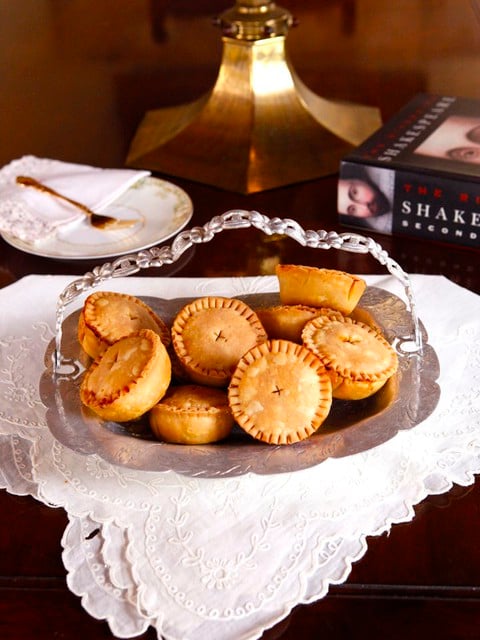
I’d like to welcome our new contributor Ken Albala! In this post, Ken explores the famed “Funeral Baked Meats” from Shakespeare’s Hamlet. Learn more about Ken here. ~ Tori
—
Although Shakespeare is not known for being gastronomically minded, many of his references do shed light on culinary practices of the Renaissance. Among the best known is the passage in Hamlet where the prince mentions that “The funeral baked meats Did coldly furnish forth the marriage tables.” This refers the pies served at his father’s funeral that have been offered again as cold leftovers at his mother Gertrude’s wedding to his uncle Claudius, one following quickly after the other. Under normal circumstances this would be an act of thrift, exactly as Hamlet says: “Thrift, Thrift Horatio.” But the phrase also refers obliquely, albeit gruesomely, to the pastry shells of the “baked meats” or pies, also known as coffins. The pastry was sometimes a vehicle for storage of the contents and wasn’t eaten, being made of coarse but sturdy free-standing rye flour. The contents would include gelatinous broth or fat to keep the contents hermetically sealed. The coffin is thus meant to protect and preserve the contents from corruption.
Titus Andronicus uses the word coffin in the same double sense when he describes his plan to put childrens’ heads into a pie to feed to their mother. “I will grind your bones to dust And with your blood and it I’ll make a paste, And of the paste a coffin I will rear And make two pasties of your shameful heads.” It is the same double metaphor of coffin as pie crust and a vessel bearing the dead. Clearly Shakespeare understood the value of gelatinous meat and bones, even human heads, in keeping the contents of the pie solid, sturdy and long lasting.
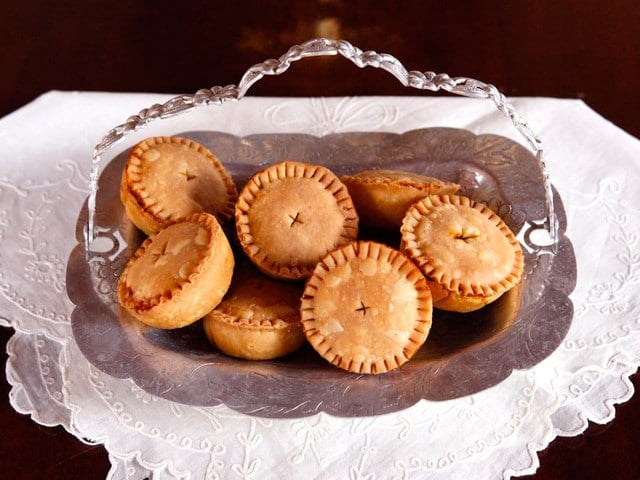
Both of these references to coffins are further clarified with a recipe. The 15th century Harleian mss. 279 has a section on baked meats (pies). They are specifically for supper, the smaller evening meal, and likewise served at room temperature, and could have been baked several days before and served much like the leftover pies at Gertrude’s wedding.
A bake Mete Ryalle.
Take and make litel cofyns, and take Chykonys y-soþe; o þer Porke y-soþe, and smale y-hackyd; oþer of hem boþe: take Clowys, Maces, Quybibes, and hakke wiþ-alle, and melle yt wiþ cromyd Marow, and lay on Sugre y-now; þan ley it on þe cofynne, and in þe myddel lay a gobet of marow, and Sugre round a-bowte y-now, and lat bake; and þis is for soperys.
Shakespeare’s other references to pie reveal that he is usually thinking of fruit inside as well, especially dates. In Troilus and Cressida we are given a seasoning metaphor to describe Troilus’s attributes.
Pandarus. Do you know what a man is? Is not
birth, beauty, good shape, discourse, manhood,
learning, gentleness, virtue, youth, liberality,
and such like, the spice and salt that season a man?
Cressida. Ay, a minced man: and then to be baked with no date
in the pie, for then the man’s date’s out.
Cressida’s quip refers to a variety of finely chopped mincemeat pie, made up of so many jumbled ingredients, each individual item, just as each personal attribute of a person, is lost in the mix. She also implies that without dates in the pie, it would be out of date, or out of fashion, or without substance.
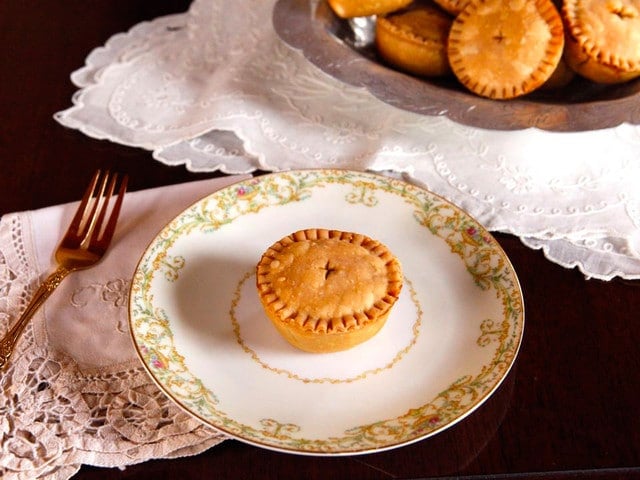
The Good Huswife’s Handmaide for the Kitchen, first published in 1588, offers a good idea of the type of pie Shakespeare is referring to here. First it is a pie with an edible crust. The author warns explicitly in a recipe to make Paste to raise Coffins, not to put too many eggs in the pastry or “it will make it drie and not pleasant in eating.” On the next page he offers exactly the sort of recipe Cressida has in mind.
To make sweete pies of Veale
Take Veale and perboyle it verie tender, then chop it small, then take twise as much beef suet, and chop it small, then minse both them together, the put Corrans and minced Dates to them, then season your flesh after this manner. Take Pepper, salt, and Saffron, Cloves, Mace, Synamon, Ginger, and Sugar, and season your flesh with each of these a quantitie, and mingle them altogether.
Presumably without the dates the pie is not only paltry, but not something likely to please – a insulting comparison directly to Troilus. The double meaning of date points directly to the reigning aesthetic of the late 16th century, when dates were still an exotic luxury, absolutely requisite in elegant and table-worthy pies.
A similar pun about date and fashion is given by Parolles in the opening scene of All’s Well that Ends Well. He is describing how virginity is of no use if kept too long.
Virginity, like an old courtier, wears her cap out
of fashion: richly suited, but unsuitable: just
like the brooch and the tooth-pick, which wear not
now. Your date is better in your pie and your
porridge than in your cheek;
The pun is that dates, the fruit, belong in pies, but date meaning age, does not wear well on a woman’s face. The lines only makes sense knowing that dates in pies are indeed still fashionable and that without them pies are not considered very interesting. We also learn, incidentally, that picking one’s teeth in public was now considered declassé.
Recommended Products:
We are a participant in the Amazon Services LLC Associates Program, an affiliate advertising program designed to provide a means for us to earn fees by linking to Amazon.com and affiliated sites. As an Amazon Associate I earn from qualifying purchases.
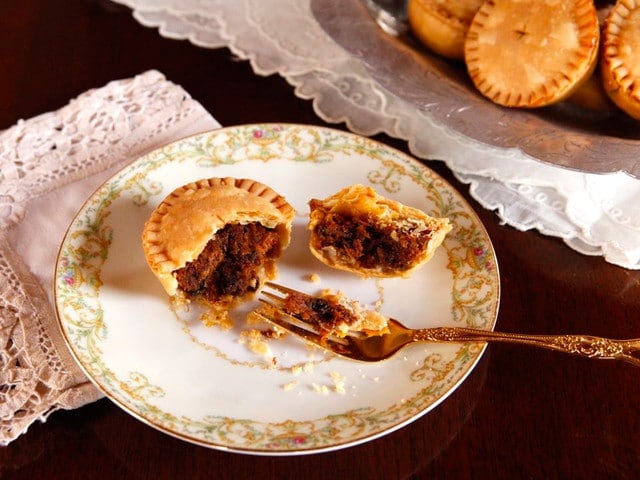
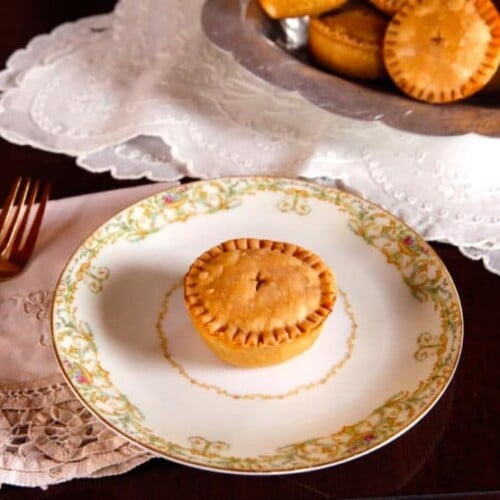
Shakespearean Meat Pies
Ingredients
Pastry Ingredients
- 4 cups pastry flour (use pastry flour for a flakier result)
- 2 large egg yolks
- 1 cup water
- 8 tablespoons butter (1 stick)
Filling Ingredients
- 1/2 pound veal shoulder meat (weight should not include bone)
- 1 pound suet (or raw beef fat - suet preferable, finely chopped but not into a paste)
- 1/4 pound dried currants
- 1/4 pound dates
- 3/4 cup sugar
- 1/2 tablespoon mace
- 1/2 tablespoon cinnamon
- 1/2 tablespoon ginger
- 3/4 teaspoon cloves
- 1/2 teaspoon salt
- 1/4 teaspoon pepper
- 1/8 teaspoon crushed saffron
NOTES
Instructions
- In a large pot, cover the veal with cold water. Cover pot with a lid and simmer until tender, about 1 ½ hours.

- Drain and allow the veal to cool. Then chop it finely with the chopped suet or beef fat. Note that suet will produce a better texture result; beef fat will make for a greasier pie, but it is easier to locate than suet so we add it here as an alternative. Add in currants, chopped dates, sugar and spices. Set aside.

- Preheat oven to 350 degrees F.To make crust, first melt the butter in 1 cup of water. Heat just until the butter is melted, do not boil.

- In a large mixing bowl, make a well in the center of the 4 cups of flour. Mix in water/melted butter mixture until well combined. Let sit until it reaches room temperature. Mix in egg yolks. The dough should come together as a ball.

- Allow dough to rest for 10 minutes, then divide into 4 equal portions.

- On a floured surface roll the dough to 1/16 inch thickness, then cut out 24 4-inch circles. Roll out remaining dough and cut into 24 3-inch circles.

- Place the larger dough circles into the bottoms of a greased muffin tin, then spoon in 2 tbsp of filling.

- Top with the smaller dough circles, pressing down to make sure that there are no air pockets between the dough and the filling. Use a fork to crimp the top and bottom edges together.

- Make a vent in the top by cutting a small “x” in the center.

- Place muffin tins on a baking sheet, then bake for 1 hour rotating the pan halfway through, till golden brown and baked through.

- If you open the oven and see that fat is draining from the pies onto the baking sheet, don't worry, this is likely to happen (especially when using beef fat in place of suet) and will not ruin the pies.

- Serve warm or at room temperature (we preferred them warm). They are similar to sweet mince pies. Note they tend to get greasy after sitting for prolonged periods of time; keep pies separated by layers of parchment or wax paper when storing.

Nutrition

tried this recipe?
Let us know in the comments!
Research Sources:
Hamlet I:ii.180.
Titus Andronicus V:3.
Austin, Thomas. Two Fifteenth-Century Cookery-Books. London: Oxford University Press, reprint, 2000.
Troilus and Cressida I:2.258.
Peachey, Stuart. Good Huswifes Handmaide for the Kitchen. Bristol: Stuart Press, 1992, p. 22.
Ibid, p. 23.
All’s Well That Ends Well I:1.
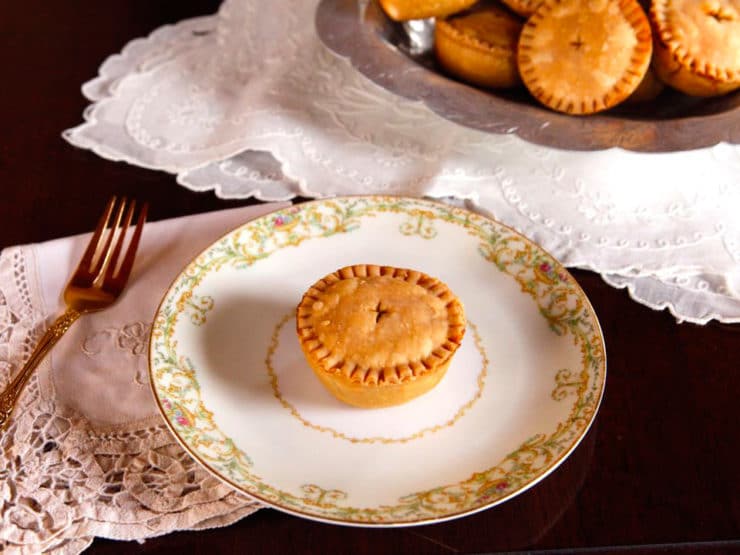
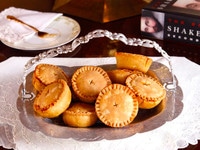
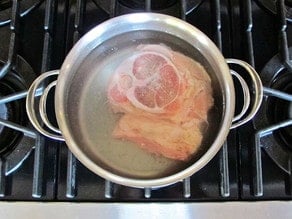
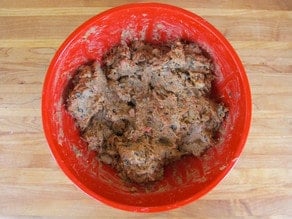
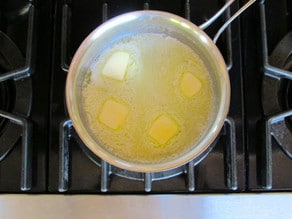
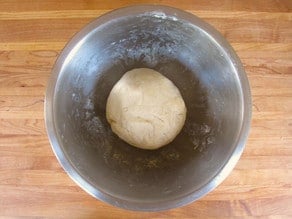
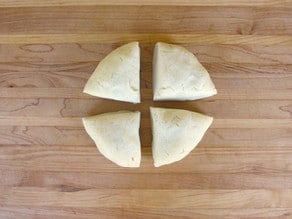
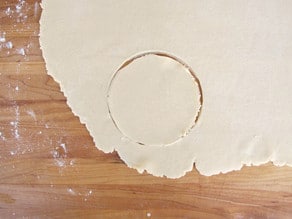
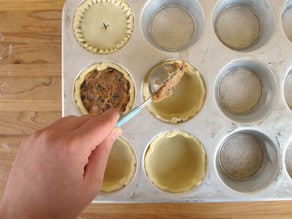
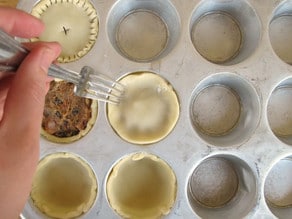
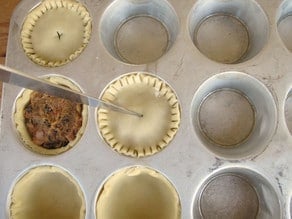
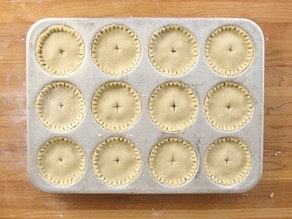

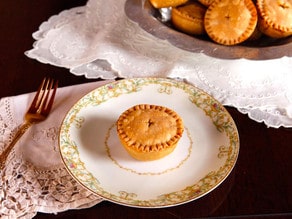


To make this recipe kosher what can I substitute the butter for in the pasty ?
Margarine (vegan butter).
If I were to make this more of a savory dish with chicken and various poultry spices, what type of fat would you recommend in place of suet? I love your recipe method, but I am not a big fan of veal. Love your site, by the way. Excellent recipes. I just discovered it researching how to make “funeral baked meats” for my own food blog.
Hi Vanessa, Tori’s assistant Ashley here. This recipe comes from Ken Albala, so I’m not sure what would make a great substitute for your recipe. We recommend beef fat and a quick search showed me that vegetable suet can be purchased on Amazon and vegetable shortening might also work.
Where did the instructions go?
Carmen I recently migrated websites to a new domain, it appears the instructions did not transfer over. I’ve asked my web team to look into it, hopefully they’ll be restored soon!
No human heads in the recipie? Color me disappointed…
Looks like a Scottish meat pie! Yum!
Funeral and baked meat are not terms one usually encounters in the same sentence…lol.
At first I thought that these were pork pies.
When I think literary meat pies, I think Sweeney Todd, not Shakespeare. Now I’ve learnt something today…
I use to make these meat pies when I work in tea houses.. These pies were made for lunch when men would go off to work Thank you the history lesson I am a lover to Shakespeare..
We are very fond of pies in England!